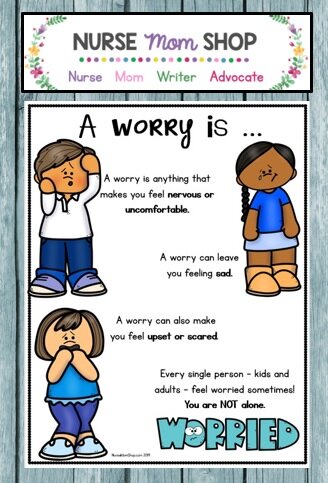Thoughts on Navigating Worries
Navigating worries is a life skill. As someone who struggles with anxiety, I am especially aware that I always want my children to feel validated when they are worrying. I long for them to know that they are not alone with their worries. I also want to give them as many tools as I can to help build their resilience.
In this post I am going to share parts of a curriculum I have created to help young children understand and navigate worries. I have broken it into three areas:
What is a Worry?
How big is my worry?
What can I do with my worries?
First, I explain to them that a worry is any thought or idea that makes them feel uncomfortable or upset.
I love using a notice, name, next approach with this. I ask my kids to notice how their body feels when they are worried. I ask them to do a “body scan” - is their heart rate racing? Do their palms feel sweaty? Next I ask them to name their worry. Anxiety is often a vague feeling of overwhelm so sometimes just the act of naming the cause can be helpful.
Once they have noticed and named how they feel, I help them think about what they could do next? We will talk more about this in a follow-up section on “What to do with my worries.”
I also find it helpful to discuss with kids that worries come in different sizes. I ask them to think about how big their current worry feels to them? If it is a small or medium worry they could try to navigate it independently. They can try one of the calm down strategies in their toolbox such as deep breathing or worry journaling. If the worry feels large and overwhelming, I encourage them to find a trusted adult to talk through it with.
The final step is to encourage them to brainstorm what they can do with this worry. I make sure they know that sometimes the answer is nothing. Sometimes with feelings of overwhelm or sadness, it is okay just to SIT with those feelings. There is a book that I love called “When Sadness is at your Door” that talks about this idea. While sadness and anxiety can be very different emotions, I find that they are often closely linked.
Other times, however, there is a good and helpful next step that can be taken. I encourage kids to think through their calm down toolbox (I have a unit on that here if you’re interested). I also encourage them to write out their worries. If a worry feels large or overwhelming I encourage them to find someone to talk with about it.
I do my best to model this practice in my own life as well. Our children are paying attention to our words but often they notice our actions even more. Last year, I was navigating a second round of postpartum anxiety. I shared parts of my journey with my twins who were seven at the time. I talked to them about how I was seeing a counselor and how I was using tools like exercise and yoga to navigate my own worries. It is helpful and normalizing for children to see that they are not the only ones who worry.
If this curriculum looks like something that might be helpful for the children in your life, you can download a section of it for free here. I truly hope it is a useful tool for you!
Life is a gift. It can also be deeply overwhelming. May we have the awareness to acknowledge that these feelings can exist together. May we have grace and patience both with our little people and also with ourselves as we navigate all of the big feelings involved with being a human!




